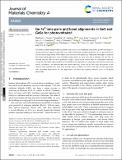Files in this item
Ge 4s2 lone pairs and band alignments in GeS and GeSe for photovoltaics
Item metadata
| dc.contributor.author | Smiles, MJ | |
| dc.contributor.author | Skelton, JM | |
| dc.contributor.author | Shiel, H | |
| dc.contributor.author | Jones, LAH | |
| dc.contributor.author | Swallow, JEN | |
| dc.contributor.author | Edwards, HJ | |
| dc.contributor.author | Murgatroyd, PAE | |
| dc.contributor.author | Featherstone, TJ | |
| dc.contributor.author | Thakur, PK | |
| dc.contributor.author | Lee, TL | |
| dc.contributor.author | Dhanak, VR | |
| dc.contributor.author | Veal, TD | |
| dc.date.accessioned | 2021-10-14T15:30:07Z | |
| dc.date.available | 2021-10-14T15:30:07Z | |
| dc.date.issued | 2021-10-21 | |
| dc.identifier | 276267835 | |
| dc.identifier | 3f89ebf2-c169-4e72-b852-7057d869854c | |
| dc.identifier | 000700540500001 | |
| dc.identifier | 85117120613 | |
| dc.identifier.citation | Smiles , MJ , Skelton , JM , Shiel , H , Jones , LAH , Swallow , JEN , Edwards , HJ , Murgatroyd , PAE , Featherstone , TJ , Thakur , PK , Lee , TL , Dhanak , VR & Veal , TD 2021 , ' Ge 4s 2 lone pairs and band alignments in GeS and GeSe for photovoltaics ' , Journal of Materials Chemistry A , vol. 9 , no. 39 , pp. 22440-22452 . https://doi.org/10.1039/d1ta05955f | en |
| dc.identifier.issn | 2050-7488 | |
| dc.identifier.other | RIS: urn:E6664B0E8C4DFDFD58523144067A058A | |
| dc.identifier.uri | https://hdl.handle.net/10023/24142 | |
| dc.description | The Engineering and Physical Sciences Research Council (EPSRC) is acknowledged for providing funding to M. J. S., J. E. N. S, and T. J. F. (Grant No. EP/L01551X/1), H. S. (Grant No. EP/N509693/1), L. A. H. J. (Grant No. EP/R513271/1), and V. R. D. and T. D. V. (Grant No. EP/N015800/1). JMS is supported by a UK Research and Innovation (UKRI) Future Leaders Fellowship (Grant No. MR/T043121/1), and previously held a University of Manchester Presidential Fellowship. The XRD facility was supported by the EPSRC under Grant No. EP/P001513/1. Diamond Light Source is acknowledged for providing beam time on beamline I09 under proposals SI21431-1 and SI23160-1. Computational modelling was performed on the UK Archer high-performance computing facility via membership of the UK Materials Chemistry Consortium, which is funded by the EPSRC (Grant No. EP/L000202, EP/R029431). | en |
| dc.description.abstract | Germanium sulfide and germanium selenide bulk crystals were prepared using a melt growth technique. X-ray photoemission spectroscopy (XPS) was used to determine ionisation potentials of 5.74 and 5.48 eV for GeS and GeSe respectively. These values were used with the previously-measured band gaps to establish the natural band alignments with potential window layers for solar cells and to identify CdS and TiO2 as sensible choices. The ionisation potential of GeS is found to be smaller than in comparable materials. Using XPS and hard X-ray photoemission (HAXPES) measurements in conjunction with density-functional theory calculations, we demonstrate that stereochemically active Ge 4s lone pairs are present at the valence-band maxima. Our work thus provides direct evidence for active lone pairs in GeS and GeSe, with important implications for the applications of these and related materials such as Ge-based perovskites. | |
| dc.format.extent | 13 | |
| dc.format.extent | 1994045 | |
| dc.language.iso | eng | |
| dc.relation.ispartof | Journal of Materials Chemistry A | en |
| dc.subject | QD Chemistry | en |
| dc.subject | NDAS | en |
| dc.subject.lcc | QD | en |
| dc.title | Ge 4s2 lone pairs and band alignments in GeS and GeSe for photovoltaics | en |
| dc.type | Journal article | en |
| dc.contributor.institution | University of St Andrews. School of Physics and Astronomy | en |
| dc.identifier.doi | https://doi.org/10.1039/d1ta05955f | |
| dc.description.status | Peer reviewed | en |
This item appears in the following Collection(s)
Items in the St Andrews Research Repository are protected by copyright, with all rights reserved, unless otherwise indicated.

